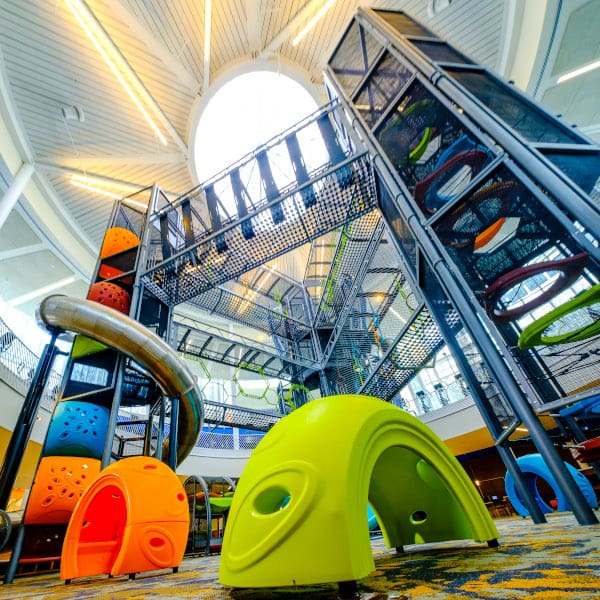The Importance of Indoor Playground Maintenance

The Importance of Indoor Playground Maintenance
Indoor playgrounds are hallmarks of many institutions. Plenty of malls, museums, places of worship, amusement parks, restaurants and gyms have soft playgrounds installed to encourage parents to visit and bring their kids. But a playground is only inviting if kept in good condition.
Play area cleaning is just one vital part of maintenance. If your business has an indoor playground, you need to embrace a routine for keeping it in good shape and making sure its surfaces are clean for kids.
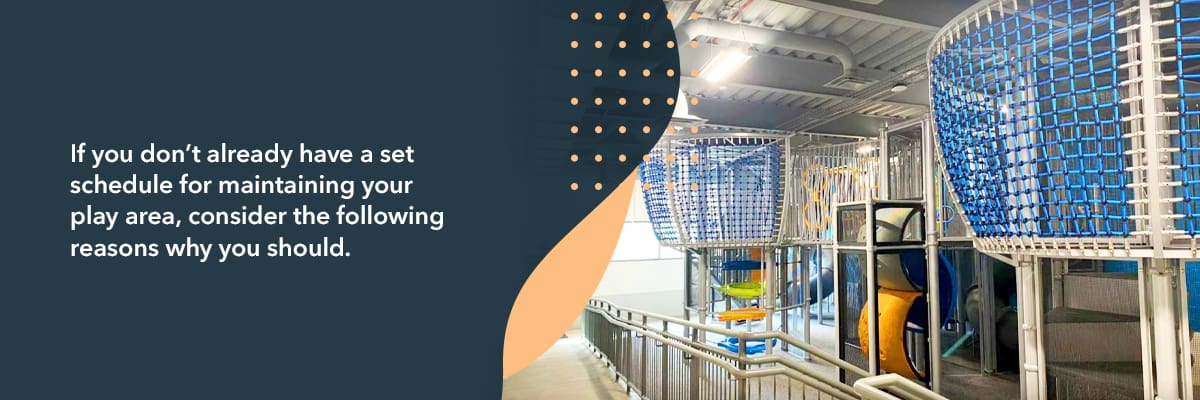
Why Indoor Playground Maintenance Is Important
Cleaning and conducting routine inspections will benefit your facility and the kids who use your playground. If you don’t already have a set schedule for maintaining your play area, consider the following reasons why you should.
It Shows Your Dedication to Cleanliness and Health
Maintaining clean facilities is a top priority for all businesses, especially when customers or their kids touch surfaces regularly. By frequently cleaning your play equipment, you can show your customers that you care about their health and well-being. They’ll be more likely to continue bringing their kids to play at your indoor playground if they trust that you can keep it clean.
It Protects Your Facility’s Investment in Playground Equipment
You invested time and money to choose and install your indoor playground, so you’ll want to ensure that you get a good return on your investment by maximizing the longevity of the play space. Regular maintenance and repairs and frequent cleaning can prevent premature wear on the equipment. Kids who visit your facility will have more years to look forward to playing at your indoor playground when you care for it properly.
It Reduces Your Business’s Liability
If you keep your indoor playground properly maintained and regularly inspected, you can minimize your risk and liability. Keep records of your maintenance and repair tasks to demonstrate the steps you’re taking to keep the play area clean and regularly serviced.
It Makes Your Playground More Enticing and Valuable
Another reason to prioritize upkeep is its ability to make your play area more enticing to kids. If kids enjoy your play area, their parents will have more of a reason to come to your facility.
Plus, when you keep your indoor play area clean, the equipment maintains its value over time. If you choose to sell your equipment to make upgrades to your playground later, you can get a better return on your investment.
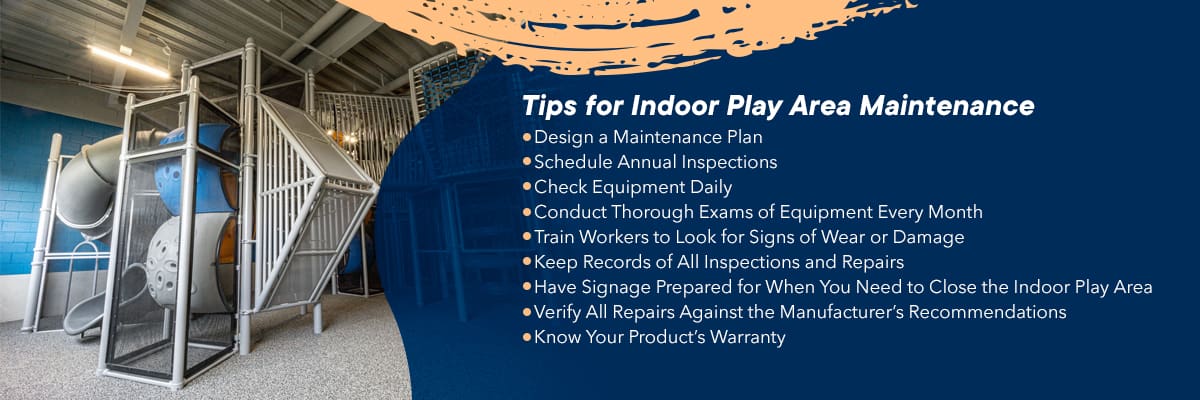
Tips for Indoor Play Area Maintenance
To keep your indoor play area well cared for, you need to be deliberate about the steps you take. Indoor classic playgrounds have multiple components and a variety of surfaces, so the steps you take for maintenance will vary depending on the design of your play area. But whatever your playground’s design or size, you can still use these tips as guidelines.
1. Design a Maintenance Plan
Start by designing a maintenance plan for your playground. Make sure to fit the schedule around your operating hours to reduce the impact on your customers. For instance, if you have seasonal operations, conduct major inspections and repairs during the offseason.
When you design your maintenance plan, make sure to write it down and inform your team about the procedures. You should also make sure everyone is aware of their responsibilities in keeping up the play area. For daily equipment checks, workers need to know what signs to look for that indicate a need for repairs.
Consult the owner’s manual for your playground equipment for recommended checks and inspections of the structures and parts.
2. Schedule Annual Inspections
Set up annual inspections of your play equipment. Choose a professional service provider in your area to conduct these inspections instead of using your staff. An expert in indoor play structures will have the training needed to identify issues that most people may miss. Plus, if the inspector finds an issue, they can set up a time to make repairs or part replacements.
Through annual inspections, you can ensure that the integrity of your indoor playground is sound. These inspections can help you find and fix minor problems before they become bigger, more costly issues. When you catch these concerns early, you can take care of them quickly so your visitors can keep enjoying the play area.
3. Check Equipment Daily
Don’t rely only on annual inspections alone to make sure your equipment is in great shape. Train workers to conduct daily checks of the equipment before opening and after closing. Create a checklist for your team to follow to ensure they look for common minor issues like the following:
- Unclean surfaces
- Exposed metals
- Cracks in surfaces
- Rust
- Damaged nets
- Vandalism
- Excessive wear and tear
- Tripping hazards
- Litter
Make sure employees know that they need to correct any minor issues they find right away. If a quick fix isn’t possible, they’ll need to flag components for repair and close that section of the play area. Have clear procedures in place for these situations so everyone is on the same page.
4. Conduct Thorough Exams of Equipment Every Month
While daily checks are important, some parts of the playground hide beneath coverings. Once a month, check the connections, nuts, bolts and other couplings on the playground. Verify that all parts are connected properly, including slides and nets.
If possible, have two workers conduct these monthly inspections so they can verify each other’s work. Alternatively, you might request an individual to check the area twice. It’s important to be as thorough as possible.
5. Train Workers to Look for Signs of Wear or Damage
Workers who aren’t in charge of conducting daily or monthly checks of the equipment should still know signs of wear and problems to look out for. They may have a customer bring a problem to their attention or identify an issue themselves during their shift. The more eyes you have on your indoor playground equipment, the greater the chances are that you can find issues at their earliest stages.
Proper training for your whole team will also make it easier to change workers’ duties as needed.
6. Keep Records of All Inspections and Repairs
Maintain records of all inspections and repairs, including copies of daily checklists for your indoor playground. These records will demonstrate that you’re putting your best effort into maintaining your play equipment and keeping it clean.
With thorough records, you can also verify the last time that you repaired equipment. Compare this information to repair or replacement intervals suggested by the manufacturer to maintain optimum integrity.
7. Have Signage Prepared for When You Need to Close the Indoor Play Area
Always be prepared to close off portions of the play area or the entire playground if you find a problem that requires repair or immediate cleaning. Having signage ready will make the process faster and easier. Plus, with the signage, you can demonstrate that your facility is putting a priority on the health and well-being of your customers and their kids. Your signs can also indicate that you’re working hard to get the play area back open as quickly as possible.
When you need to close the play area, keep workers nearby to watch the area and prevent kids too young to read the signs from using the equipment. These employees will also provide valuable customer service by gently explaining the situation to parents and reassuring them that the play space will reopen once cleaned or repaired.
8. Verify All Repairs Against the Manufacturer’s Recommendations
When conducting any repairs to your indoor playground, always verify that the methods adhere to the manufacturer’s recommendations. If you want to ensure that your equipment has the best care, contact your local distributor for information about nearby service providers. Local service providers can set up regular checks and inspections of the indoor playground to ensure it’s in great shape. You can contact Soft Play® for information on company-trained and certified contractors for cleaning or repair.
You should also get all replacement parts directly from the manufacturer to ensure a proper fit and compatibility — especially if your play equipment comes with a warranty. If you don’t know the names of the parts you need, you can send a picture to the company to get help with getting a replacement.
9. Know Your Product’s Warranty
Many indoor playgrounds have warranties to cover their construction and installation. For instance, Soft Play has a limited one-year warranty after the installation of an indoor playground. This warranty covers defects in workmanship and materials.
Keep a copy of this warranty and mark its expiration date on your calendar. If you have any issues with your playground that might fall under the warranty, contact the manufacturer for more information on repairs or replacements. You could save money on the repairs. The only way to know is by reading and understanding what your indoor playground’s coverage is.
How to Clean Your Indoor Playground
Cleaning your indoor playground is just as important as maintaining the structure. Keeping surfaces cleaned and sanitizing them occasionally can give parents who let their kids play at your playground peace of mind. Plus, you can maintain the appearance of the playground through regular cleaning.
As with maintenance and inspections, it’s important to have a regular schedule for cleaning. Incorporate cleaning into your employees’ daily routines. Be sure to store cleaning supplies and products near the play area so your workers will have easy access to them. Your team should conduct cleaning at least once a day or more.
Here are a few best practices for play area cleaning to keep in mind.
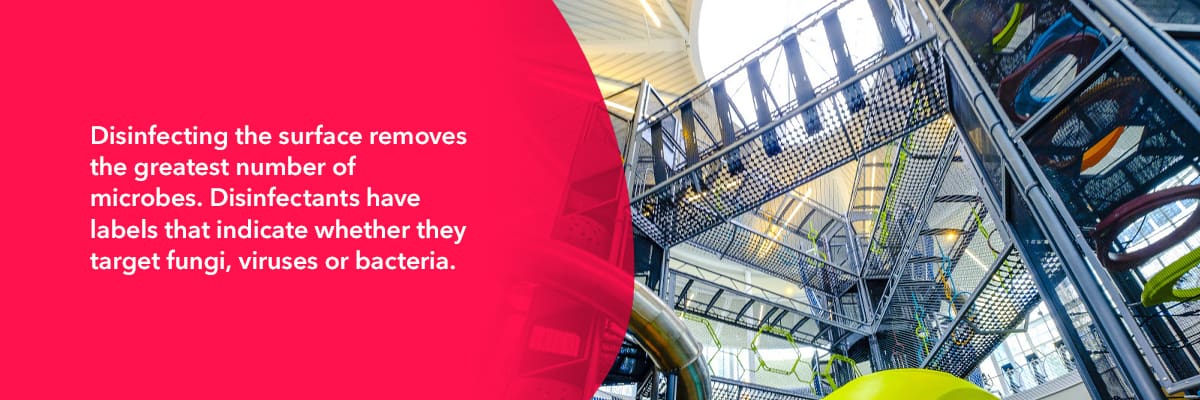
1. Understand the Differences Between Cleaning, Sanitizing and Disinfecting
First, you need to know the differences between cleaning, sanitizing and disinfecting. Cleaning removes only the dirt, chemicals and microbes from the surface. Some germs may remain even after cleaning.
Sanitizing dramatically reduces the number of germs by using chemical cleaning agents. These cleaning agents work best when used after washing surfaces with soap and water.
Disinfecting the surface removes the greatest number of microbes. Disinfectants have labels that indicate whether they target fungi, viruses or bacteria. The type of microbes targeted by disinfectants should be eliminated after treatment. As with sanitizing, it’s best to disinfect surfaces after cleaning.
To optimize the healthfulness of your indoor playground, always combine sanitizing or disinfecting with every cleaning.
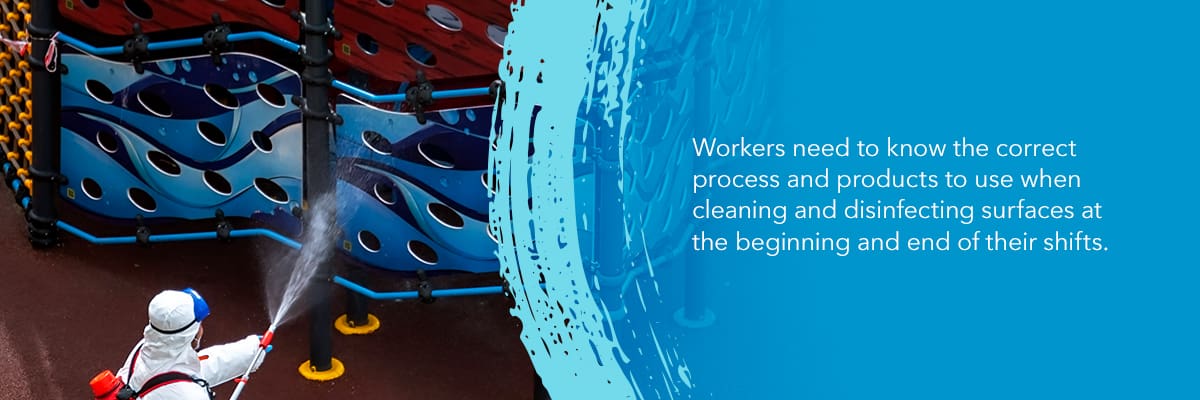
2. Train Staff in Proper Procedures for Routine Cleaning and Incident Response
Train your team to make sure everyone knows how to clean the play area routinely and in response to specific incidents. Workers need to know the correct process and products to use when cleaning and disinfecting surfaces at the beginning and end of their shifts. They should also know how to scan for places that might need spot cleanings, such as muddy areas. Your play area should always look its best for visitors.
Incident response cleaning is essential for spills of bodily fluids or foods. These concerns call for immediate attention.
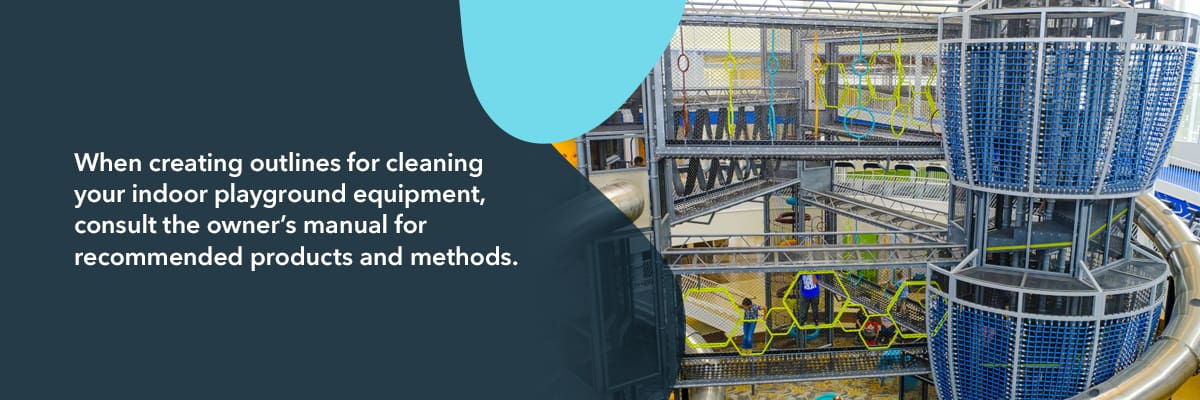
3. Know the Manufacturer’s Guidelines for Your Equipment
When creating outlines for cleaning your indoor playground equipment, consult the owner’s manual for recommended products and methods. For instance, you should never use petroleum-based cleaning products with playground equipment from Soft Play. Doing so could cause localized damage or structural integrity loss.
4. Follow These Routine Cleaning Procedures Every Day
When cleaning your playground daily, your team should do the following:
- Wear gloves throughout the cleaning process.
- Clean most surfaces with soap and water.
- Use scrubbing brushes on scratch-resistant surfaces.
- Avoid cleaning with paper towels or scrub brushes on windows or domes to prevent scratching.
- Use only ammonia-free cleaners on windows.
- Select a nontoxic disinfectant or sanitizer for your indoor playground equipment. You can use a combination of 1 gallon of water with 1/3 cup bleach dissolved in it. A solution of 70% alcohol will also disinfect surfaces.
- Never mix any cleaning agents.
- Clean the equipment as instructed on the cleaning agent’s label.
Frequent cleaning throughout the day and at the end of every shift will help to create the best possible environment for your guests. Make sure you have a cleaning checklist employees can follow for consistent results.
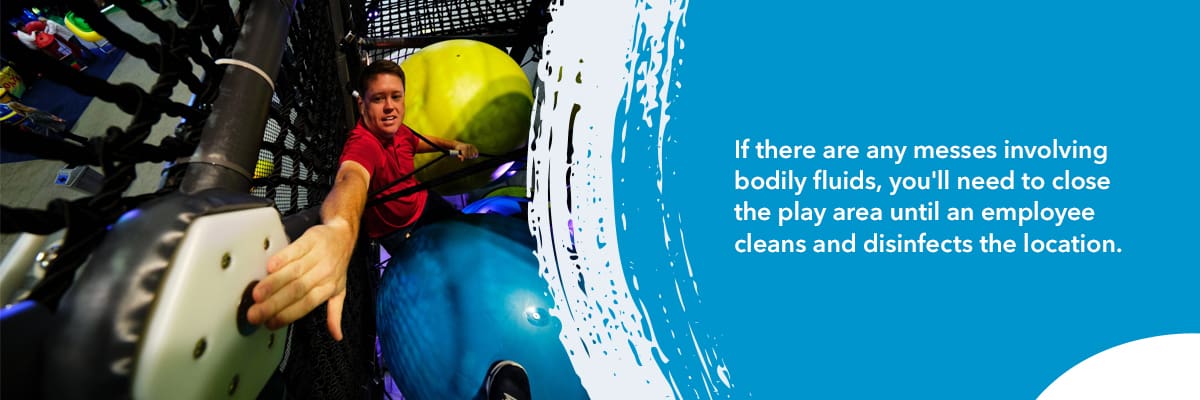
5. Respond to Incidents Involving Spills or Body Fluids With Appropriate Cleaning Methods
Employees need to watch for incidents on the playground and respond to them immediately. If there are any messes involving bodily fluids, you’ll need to close the play area until an employee cleans and disinfects the location.
To clean an area where bodily fluids have spilled, the employee needs to first put on gloves. They should clean up the fluids with disposable towels and follow the remaining steps for disinfecting the surface:
- Discard the towels in a plastic bag and place the bag into a covered trash can.
- Wash the area with soap and water, being careful to prevent splashing.
- Spray the surface with disinfectant as directed by the label.
- Allow the area to air-dry to maximize contact of the disinfectant with the surface.
- Do not reopen the space until the disinfectant completely dries.
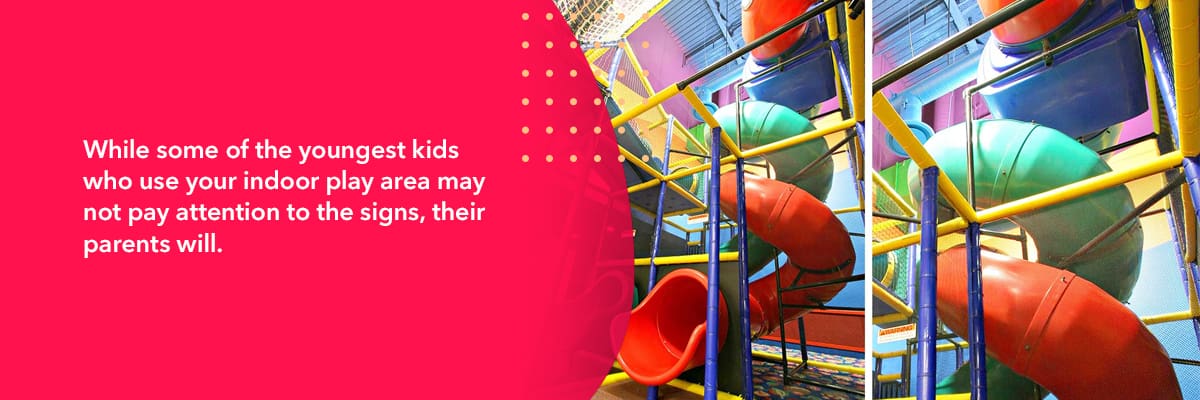
6. Incorporate Signage Into Your Play Area to Inform Guests of Cleaning Procedures and Best Practices
Signs are often the most effective way to convey information about your cleaning procedures to your customers. While some of the youngest kids who use your indoor play area may not pay attention to the signs, their parents will. These signs should explain that your employees clean the playground before and after opening and following any incidents.
You should also put signs up at the entrances and around the play area to provide rules for kids in the playground. Here are some basic cleanliness rules to include:
- Do not enter the play area if you’re sick.
- Do not bring food or drinks into the play area.
- Report any spills to an employee right away.
- Wash hands or use hand sanitizer before and after playing in the playground.
These guidelines will help to reduce the number of spills your employees have to respond to. Clear signage can also give parents peace of mind that you have effective cleaning procedures in place.
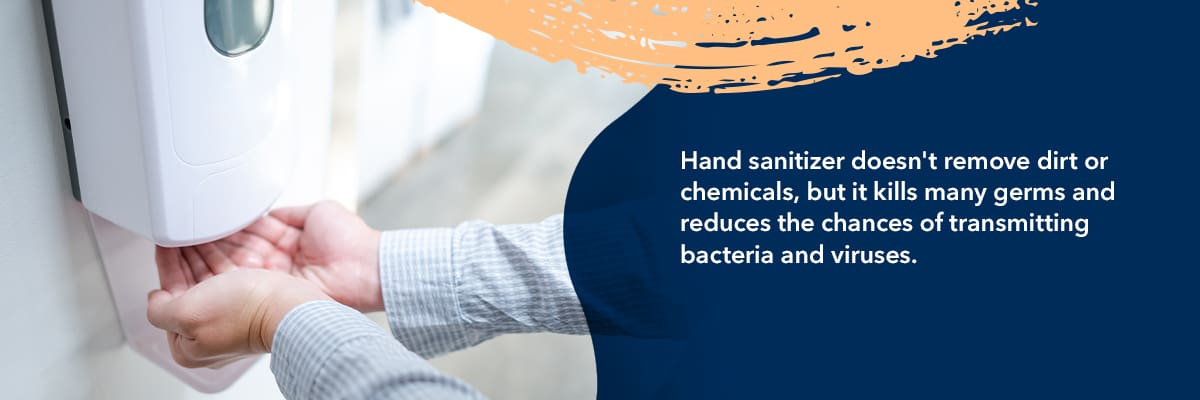
7. Provide Hand Sanitizer Stations at the Play Area
Hand sanitizer doesn’t remove dirt or chemicals, but it kills many germs and reduces the chances of transmitting bacteria and viruses. It can serve as a good alternative to hand-washing when sinks aren’t available. It’s a good idea to have hand sanitizer available near your play area so kids can use it before and after they use the equipment.
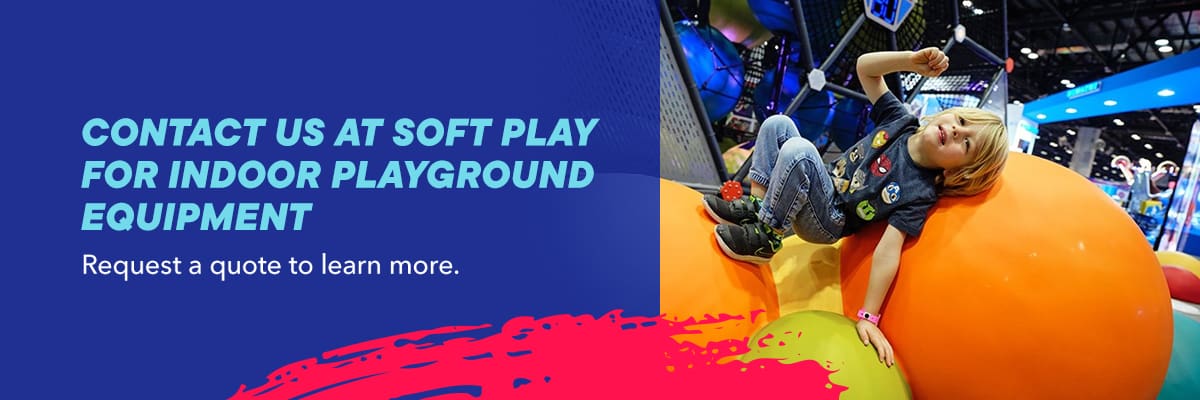
Contact Us at Soft Play for Indoor Playground Equipment
Regular maintenance and cleaning can make your indoor playground last for years. Start with high-quality play elements from Soft Play. We’ve been creating customized play area solutions since our humble beginnings in a garage in 1984.
Today, we create equipment for play spaces all around the world. Our equipment undergoes rigorous forms of testing to ensure durability. We also provide friendly, knowledgeable customer service whenever you have questions about maintaining, cleaning, upgrading or repairing your equipment. For a quote on a customized indoor playground from Soft Play or more information about what we offer, contact us today.
